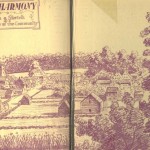In 1908, William S. Garber, the official reporter in the Marion County Courts, presented a paper to the county Bar Association about the nation’s increasing divorce rate. Even though it seemed that the institution of marriage in the twentieth century had gotten off to a rocky start, Hoosier courts had seen worse.
In fact, until 1873, Indiana used to have one of the most liberal divorce laws in the country, and unhappily married individuals flocked to the Hoosier state in order to bring their unions to a quick—and relatively painless—end. According to Garber, in those days judges were inclined to grant a divorce decree “as a matter of course in every case where the defendant did not appear and oppose it.” The applicant had only to provide “proof of residence” and swear under oath that there was “statutory cause” for their petition.
In fact, although Indiana’s divorce law required the applicant to be a resident of the state and the county where the action was filed, there was no requirement concerning the length of one’s residency. The absence of such a requirement, coupled with language allowing courts to dissolve marriages for “any other cause . . . deem[ed] proper,” made the Hoosier state a prime destination for those seeking a divorce.
Garber described the law as opening the courts of Indiana “to all the dissatisfied couples in the United States”–and that was said with little exaggeration. However, the ease with which one could terminate a marriage in Indiana did not enhance the state’s reputation nationwide. An October 13, 1858, story in the Chicago Press and Tribune wrote of the “divorce scandal in Indiana.” The article counted 10 divorce cases alone pending in the Vigo Circuit Court, and 17 in Tippecanoe County—14 of which involved couples from other states—leaving the paper to wonder why the people of Indiana had tolerated this “crying disgrace” for so long.
In a more strident editorial printed on December 14 of the same year, the same Chicago newspaper condemned the “cheap and easy method of divorce” available in Indiana, and charged that Indiana lawmakers had “practically legalized Free Love and its endless and nameless abominations, not only for themselves but for half the Union besides.”
Indiana’s towns, the writer charged, now “swarmed” with women unhappily married to “sots, beasts, or debauchers”’ as well as with “fast women who feel that all husbands are nuisances; fast men who prove the fact in part; silly women who have married in haste and are repenting at leisure; silly men, ditto ditto”—and these cases numbered in the thousands. The editorial breathlessly urged Hoosiers to reform their divorce laws as soon as possible.
The state did reform its divorce laws in the 1870s, and in 1889, the Chicago Daily Tribune remarked that Indiana’s “fame as a quick and easy divorce mill” was being eclipsed by other states’ lax laws for ending marriages. But for a few decades in middle of the nineteenth century, Indiana’s name was synonymous with sin and cupidity, and the Hoosier state was a sad symbol for those bemoaning the effect of modern times on the institution of marriage.
A Moment of Indiana History is a production of WFIU Public Radio in partnership with the Indiana Public Broadcasting Stations. Research support comes from Indiana Magazine of History published by the Indiana University Department of History.
Sources include:
1. “The Divorce Scandal in Indiana.” Chicago Press and Tribune, October 13, 1858, p. 2.
2. “Divorce in Indiana.” Chicago Press and Tribune, December 14, 1858, p. 2.
3. “Indiana’s Decay as a Divorce Center.” Chicago Daily Tribune, December 28, 1889, p. 9.
4. William S. Garber, “Divorce in Marion County,” Indiana Magazine of History 6, no. 1 (Mar. 1910): 1-16.





















